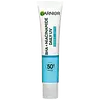What's inside
What's inside
 Key Ingredients
Key Ingredients

 Benefits
Benefits

 Concerns
Concerns

No concerns
 Ingredients Side-by-side
Ingredients Side-by-side

Zinc Oxide
Cosmetic ColorantWater
Skin ConditioningDibutyl Adipate
EmollientDicaprylyl Carbonate
EmollientCoco-Caprylate
EmollientMaleated Soybean Oil Glyceryl/Octyldodecanol Esters
Pentylene Glycol
Skin ConditioningPropanediol
SolventPolyglyceryl-4 Diisostearate/Polyhydroxystearate/Sebacate
EmulsifyingSqualane
EmollientButyloctyl Salicylate
Skin ConditioningCetyl Alcohol
EmollientTocopherol
AntioxidantBisabolol
MaskingEctoin
Skin ConditioningHippophae Rhamnoides Fruit Oil
Skin ProtectingInulin
Skin ConditioningCarnosine
Skin ConditioningSodium Gluconate
Skin ConditioningCaprylyl Glycol
EmollientHydroxyacetophenone
AntioxidantZinc Oxide, Water, Dibutyl Adipate, Dicaprylyl Carbonate, Coco-Caprylate, Maleated Soybean Oil Glyceryl/Octyldodecanol Esters, Pentylene Glycol, Propanediol, Polyglyceryl-4 Diisostearate/Polyhydroxystearate/Sebacate, Squalane, Butyloctyl Salicylate, Cetyl Alcohol, Tocopherol, Bisabolol, Ectoin, Hippophae Rhamnoides Fruit Oil, Inulin, Carnosine, Sodium Gluconate, Caprylyl Glycol, Hydroxyacetophenone
Water
Skin ConditioningAlcohol Denat.
AntimicrobialDiisopropyl Sebacate
EmollientSilica
AbrasiveIsopropyl Myristate
EmollientEthylhexyl Salicylate
UV AbsorberEthylhexyl Triazone
UV AbsorberBis-Ethylhexyloxyphenol Methoxyphenyl Triazine
Skin ConditioningButyl Methoxydibenzoylmethane
UV AbsorberGlycerin
HumectantNiacinamide
SmoothingPropanediol
SolventC12-22 Alkyl Acrylate/Hydroxyethylacrylate Copolymer
StabilisingDrometrizole Trisiloxane
UV AbsorberPerlite
AbsorbentCaprylic/Capric Triglyceride
MaskingTocopherol
AntioxidantHydroxyacetophenone
AntioxidantHydroxyethylcellulose
Emulsion StabilisingSodium Benzoate
MaskingSodium Phosphate
BufferingTriethanolamine
BufferingTrisodium Ethylenediamine Disuccinate
Silica Silylate
EmollientSalicylic Acid
MaskingPolysorbate 60
EmulsifyingZinc PCA
HumectantAloe Barbadensis Leaf Juice
Skin ConditioningCaprylyl Glycol
EmollientTerephthalylidene Dicamphor Sulfonic Acid
UV AbsorberAcrylates/C10-30 Alkyl Acrylate Crosspolymer
Emulsion StabilisingSarcosine
Skin ConditioningDisodium Phosphate
BufferingCitric Acid
BufferingPotassium Sorbate
PreservativeWater, Alcohol Denat., Diisopropyl Sebacate, Silica, Isopropyl Myristate, Ethylhexyl Salicylate, Ethylhexyl Triazone, Bis-Ethylhexyloxyphenol Methoxyphenyl Triazine, Butyl Methoxydibenzoylmethane, Glycerin, Niacinamide, Propanediol, C12-22 Alkyl Acrylate/Hydroxyethylacrylate Copolymer, Drometrizole Trisiloxane, Perlite, Caprylic/Capric Triglyceride, Tocopherol, Hydroxyacetophenone, Hydroxyethylcellulose, Sodium Benzoate, Sodium Phosphate, Triethanolamine, Trisodium Ethylenediamine Disuccinate, Silica Silylate, Salicylic Acid, Polysorbate 60, Zinc PCA, Aloe Barbadensis Leaf Juice, Caprylyl Glycol, Terephthalylidene Dicamphor Sulfonic Acid, Acrylates/C10-30 Alkyl Acrylate Crosspolymer, Sarcosine, Disodium Phosphate, Citric Acid, Potassium Sorbate
 Reviews
Reviews

Ingredients Explained
These ingredients are found in both products.
Ingredients higher up in an ingredient list are typically present in a larger amount.
Caprylyl Glycol is a humectant and emollient, meaning it attracts and preserves moisture.
It is a common ingredient in many products, especially those designed to hydrate skin. The primary benefits are retaining moisture, skin softening, and promoting a healthy skin barrier.
Though Caprylyl Glycol is an alcohol derived from fatty acids, it is not the kind that can dry out skin.
This ingredient is also used as a preservative to extend the life of products. It has slight antimicrobial properties.
Learn more about Caprylyl GlycolHydroxyacetophenone is antioxidant with skin conditioning and soothing properties. It also boosts the efficiency of preservatives.
This ingredient is not irritating or sensitizing.
Propanediol is an all-star ingredient. It softens, hydrates, and smooths the skin.
It’s often used to:
Propanediol is not likely to cause sensitivity and considered safe to use. It is derived from corn or petroleum with a clear color and no scent.
Learn more about PropanediolTocopherol (also known as Vitamin E) is a common antioxidant used to help protect the skin from free-radicals and strengthen the skin barrier. It's also fat soluble - this means our skin is great at absorbing it.
Vitamin E also helps keep your natural skin lipids healthy. Your lipid skin barrier naturally consists of lipids, ceramides, and fatty acids. Vitamin E offers extra protection for your skin’s lipid barrier, keeping your skin healthy and nourished.
Another benefit is a bit of UV protection. Vitamin E helps reduce the damage caused by UVB rays. (It should not replace your sunscreen). Combining it with Vitamin C can decrease sunburned cells and hyperpigmentation after UV exposure.
You might have noticed Vitamin E + C often paired together. This is because it is great at stabilizing Vitamin C. Using the two together helps increase the effectiveness of both ingredients.
There are often claims that Vitamin E can reduce/prevent scarring, but these claims haven't been confirmed by scientific research.
Learn more about TocopherolWater. It's the most common cosmetic ingredient of all. You'll usually see it at the top of ingredient lists, meaning that it makes up the largest part of the product.
So why is it so popular? Water most often acts as a solvent - this means that it helps dissolve other ingredients into the formulation.
You'll also recognize water as that liquid we all need to stay alive. If you see this, drink a glass of water. Stay hydrated!
Learn more about Water